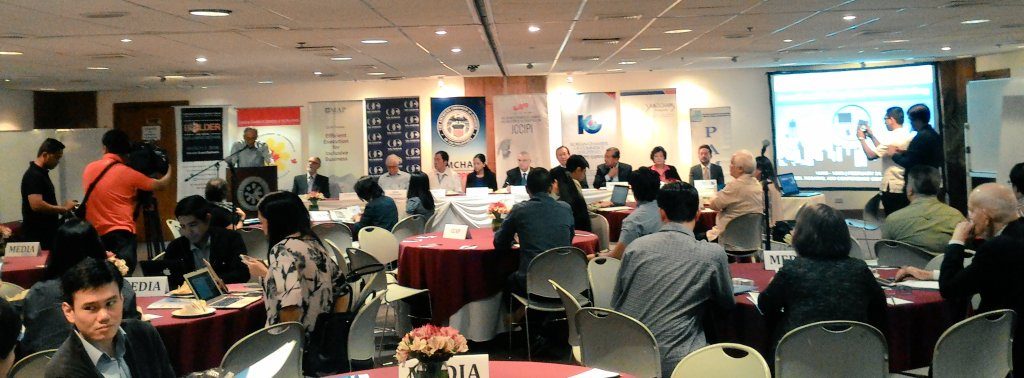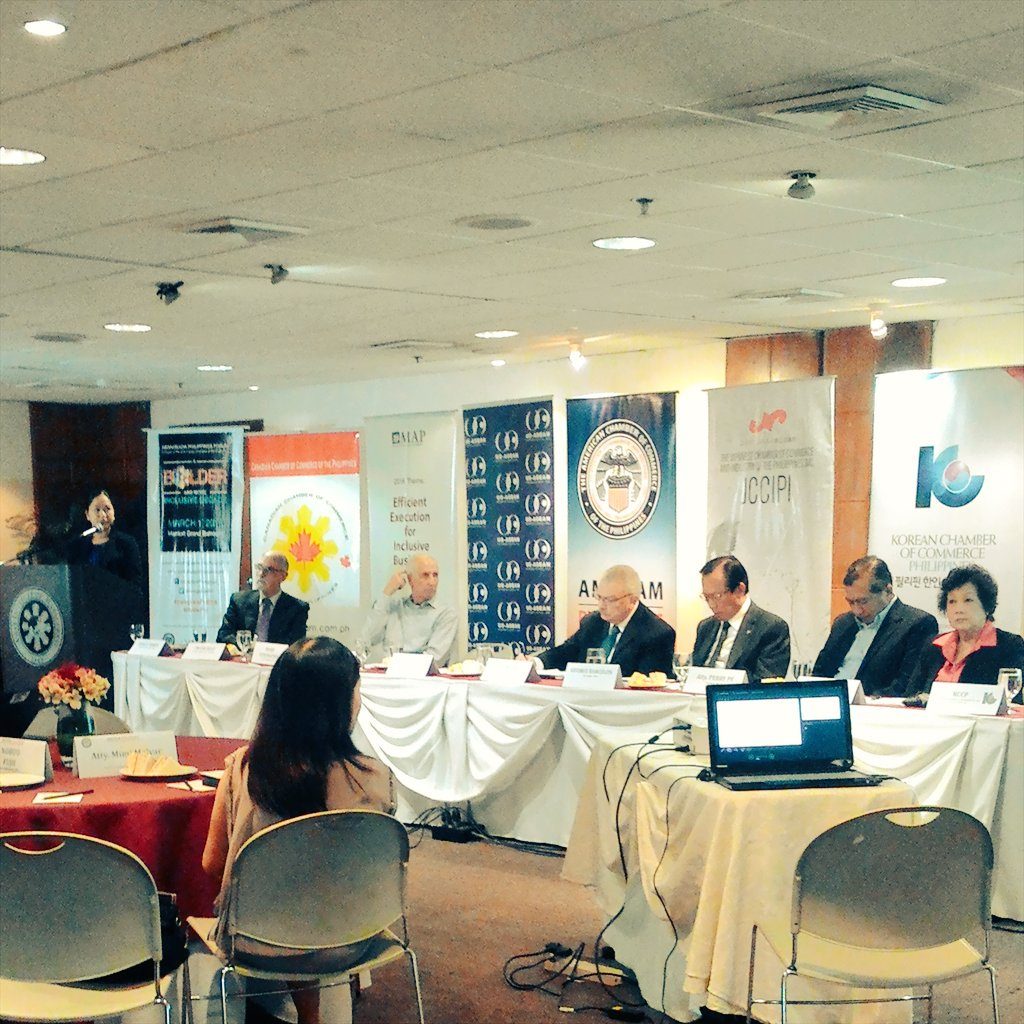SUMMARY
This is AI generated summarization, which may have errors. For context, always refer to the full article.

MANILA, Philippines – It is not the re-allocation of San Miguel Corporation’s unused 700 megahertz (MHz) spectrum that will improve Internet services in the Philippines, said some of the country’s leading business groups and information and communications technology (ICT) think tanks.
Rather, better Internet will entail adopting the open access model, updating laws and the regulatory framework, leveling the playing field, and upgrading the country’s ICT strategy, said the Joint Foreign Chambers of the Philippines (JFC) and some of the country’s largest ICT think tanks in a press briefing in Makati City on Wednesday, February 24.
During the briefing, the business groups also launched and showed support for Philippine Broadband: A Policy Brief, authored by Grace Mirandilla-Santos, vice president for policy of the Internet Society (ISOC) – Philippines Chapter.
The policy brief tackles the country’s poor Internet quality and costly Philippine broadband penetration.
“[T]here is no technical justification for the 700 MHz spectrum. It is not going to improve services. It is not the main point,” ISOC – Philippines Chairman Winthrop Yu said on the sidelines of the press conference.
‘No spectrum scarcity’
Yu added there is no spectrum scarcity in the Philippines and that telcos Philippine Long Distance Telephone Company (PLDT) and Globe Telecom, Incorporated should instead “manage properly their allocated spectrum.”
San Miguel holds most of the 700 MHz in addition to its 800,1800, 2300, and 2500 frequency bands.
PLDT, meanwhile, has rights to the 800 MHz, 900 MHz, 1,800 MHz, and 2,100 MHz bands. Globe holds the 900 MHz, 1,800 MHz, and 2,100 MHz bands.
The 700-MHz spectrum is said to be San Miguel’s most valuable asset because of a potential joint venture with Australia’s Telstra for a third major telecommunications firm in the Philippines.
For Mirandilla-Santos, who is also a research fellow of regional ICT policy think tank LIRNEasia, the Philippines might need to apply a “use it or lose it” policy to manage the spectrum and ensure resources are maximized.
“The Philippines is an archipelago in the middle of the West Philippine Sea. We have no neighbors with whom we have conflicts of spectrum. [T]hey [Globe and PLDT] want a piece of someone else’s spectrum… San Miguel legally acquired its spectrum, the same way they acquired theirs,” Yu also said.
“So if they want NTC to confiscate San Miguel’s, perhaps NTC [National Telecommunications Commission] should confiscate everyone else’s spectrum,” he added.

PLDT: We want equitable allocation, not confiscation
But for PLDT spokesperson Ramon Isberto, the two telecommunication firms did not ask for confiscation of the unutilized spectrum, but only for its “equitable allocation.”
“To our knowledge, there is no formal order from NTC to re-classify it from broadcast to telecom. First thing that has to be done is to re-classify, and then ask: How are we going to re-allocate it?” Isberto told Rappler in Makati on Wednesday.
PLDT earlier said the spectrum will help bridge the digital divide, pointing out that the long range of radio over the 700 MHz band will be especially beneficial for underserved, rural areas.
As early as 2005, PLDT and Globe said they already wrote the NTC requesting for an allocation and assignment of frequencies within the 700 MHz and 800 MHz for their broadband wireless network.
Under Philippine Broadband: A Policy Brief published this month, there are 4 urgent tasks the NTC needs to accomplish:
- assume a proactive regulatory stance on competition-related issues
- enforce strict reporting requirements on regulatees (industry players)
- strive to restore regulatees’ confidence in the Commission
- work with the legislature to introduce changes in the regulatory structure
Among the solutions being eyed by the business groups and think tanks are adopting an open access model, where segments of the Internet infrastructure will be opened up to more local and foreign players; as well as updating and upgrading laws and policies, which include amendments to the Public Telecommunications Policy Act and the enactment of the bill creating a Department of ICT.
The policy brief also recommended leveling the playing field by promoting open and neutral internet exchange points (IXPs), encouraging infrastructure sharing, and developing a national broadband plan.
It also calls for the improvement of spectrum management in the Philippines and protection of the competitiveness of the telecommunications industry.
“With an open access model, you will have more and different independent players in each of the segments. They will compete based on better services,” Mirandilla-Santos said during the briefing.
She added that the government should also reorganize the NTC.
“You need to recognize that they do not have the resources to operate or do their mandate. We recommend fixed terms for commissioners and having exemption for key personnel from salary standardization law,” Mirandilla-Santos said.
For Yu, a third major telecommunications player in the country is needed to make Philippine broadband competitive.
“We really do need more players in this sector. Otherwise, even the most powerful regulator can’t do much,” Yu said.
According to the recently-launched ICT policy brief, Internet access in the Philippines is growing but at a much slower pace compared to Association of the Southeast Asian Nations (ASEAN) neighbors.
According to Ookla, the Philippines offered the second most expensive retail Internet service in the fourth quarter of 2014 out of the 62 countries that were ranked.
Meanwhile, LIRNEasia’s broadband quality of service experience (QoSE) study in the same period found that Philippine Internet service providers offered the lowest value for money compared to its neighbors. This is in terms of actual download speed experienced by customers versus the cost of a monthly data plan.
PLDT and Globe dominate the Philippine telco market, having some of the highest earnings before interest, tax, depreciation, and amortization (EBITDA) margins compared to telcos globally.
Over the past few years, the policy brief said PLDT and Globe recorded EBITDA margins of 40% to 45%. – Rappler.com
Add a comment
How does this make you feel?
There are no comments yet. Add your comment to start the conversation.